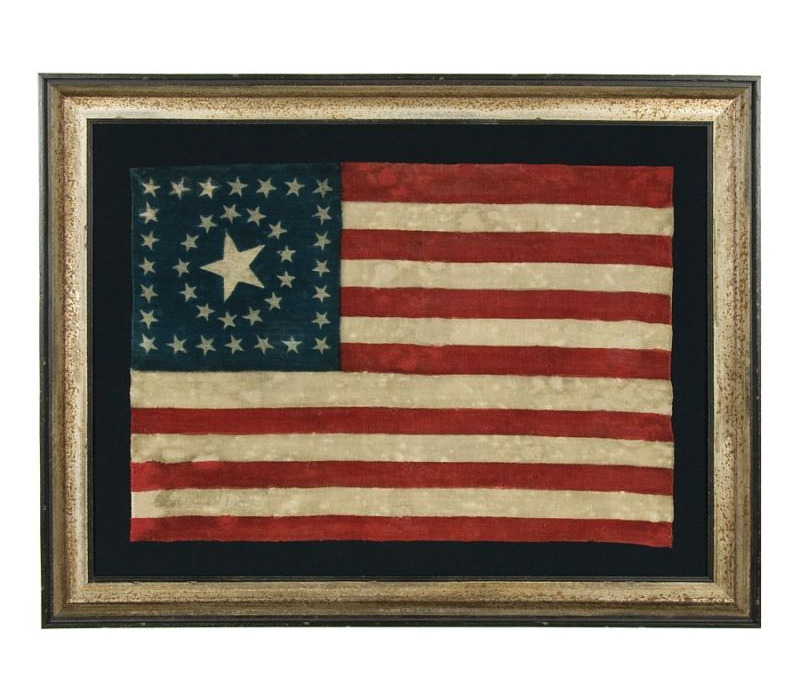
| |
38 STARS IN A RARE AND HIGHLY DESIRED CIRCLE-IN-A-SQUARE CONFIGURATION, AND WITH A HUGE CENTER STAR, MADE FOR THE 1876 CENTENNIAL CELEBRATION IN PHILADELPHIA, COLORADO STATEHOOD |
|
| Available: |
Sold |
| Frame Size (H x L): |
36.25" x 46.5" |
| Flag Size (H x L): |
25.5" x 35.5" |
|
| Description....: |
|
38 STARS IN A RARE AND HIGHLY DESIRED CIRCLE-IN-A-SQUARE CONFIGURATION, AND WITH A HUGE CENTER STAR, MADE FOR THE 1876 CENTENNIAL CELEBRATION IN PHILADELPHIA, COLORADO STATEHOOD:
38 star American national parade flag, press-dyed on wool bunting, with an exceedingly rare type of medallion star pattern. This consists of a huge center star, surrounded by a wreath of stars, with a square of stars surrounding the perimeter. I have seen fewer than 25 flags with variations of this circle-in-a-square design, making it significantly more rare than the coveted "great star" pattern.
Many fantastic star patterns were made in the patriotism that accompanied or nation's 100-year anniversary of independence in 1876 and this is among the best of all examples. Note how the vertical alignment of the stars varies greatly and that the center star tilts in the 1:00 position. There were no regulations concerning either star configuration or position until 1912, and many flag-makers went out of their way to catch the attention of potential buyers.
This rare design came in three different sizes that I have encountered, of which this is the largest. With small printed flags, larger is better until the size gets unmanageable. At approximately twenty-six by thirty-six inches, the size of this flag is all but ideal. It's large enough to make a bold statement but small enough to be hung in a wide variety of settings.
It is very likely that this flag was made for Horstmann Brothers, a major military outfitter. Horstmann did not make their own flags, but marked their name on many of the things they sold. Of the other known examples of this exact flag, two have sleeves sewn along the hoist, on which the Horstmann name was printed. Due to the fact that the company was located in Philadelphia, and the fact that this flag was found in the Philadelphia area, and the fact that the Centennial International Exposition took place in the same city in 1876, it is logical to assume that Horstmann supplied these flags for this event.
Though cotton absorbs water, most parade flags were made of cotton, because cotton was inexpensive and such flags were often intended for just one day's use only at a specific parade, rally, or reunion of soldiers. The Centennial Expo lasted for six months, however, requiring decorative flags that would last for a much longer time frame. It is reasonable to assume that press-dyed wool flags were made for just such a purpose, because wool sheds water is more appropriate than cotton for extended outdoor use.
The name "Prince" was written upside down, in large block letters, in the last white stripe, below the canton. This would have been the name of a former owner and it was common to mark flags like this in the 19th and early 20th centuries. Because it was large and distracting, I had it professionally cleaned and reduced. The name is still faintly visible, however, which is nice because it's still viewable, yet is no longer visually distracting.
The 38th state, Colorado, received its statehood on August 1st, 1876. This was just 28 days after the official anniversary of our nation's independence, which occurred on July 4th. Although 37 was the official star count in 1876, flag-making was a competitive venture, and no one wanted to be making 37 star flags when others were making 38's. It is for this reason that 38 and 13 (made to commemorate the original 13 colonies) are the two star counts most often seen at the centennial celebration. The 38 star flag was generally used until 1889, when four new states joined the Union.
Mounting: The flag was hand-stitched throughout to 100% silk for support before it was hand-stitched to a background of 100% cotton twill, black in color. The black fabric was washed to remove excess dye. An acid-free agent was added to the wash to further set the dye and the fabric was heat-treated for the same purpose. 100% natural fabrics of similar coloration were sewn between the supportive silk and the flag, both to strengthen its color against the black background and for masking purposes. The mount was then placed in a paint decorated gilded molding of the 1830-1870 period, with a rippled profile. The front is U.V. protective acrylic.
Condition: There is a significant amount of breakdown and fabric loss throughout, but this is a very rare, desirable, and dynamic design. Many of my clients prefer early flags to show their age and history of use. This one shows more losses than most, but once again, its rarity and desirability trump the damage. The flag presents quite beautifully because of the skillful placement of masking fabrics (see Mounting, above). |
|
|
|
| Collector Level: |
Flags for the truest Patriots. My best offerings |
|
| Flag Type: |
Parade flag |
|
| Star Count: |
38 |
|
| Earliest Date of Origin: |
1876 |
|
| Latest Date of Origin: |
1876 |
|
| State/Affiliation: |
Colorado |
|
| War Association: |
1866-1890 Indian Wars |
|
| Price: |
Please email or call (717) 676-0545 or (717) 502-1281 |
|
| |
Views: 3590 |
|
|
|

